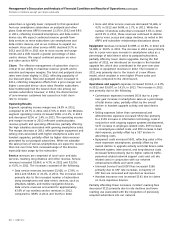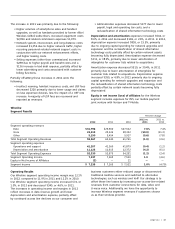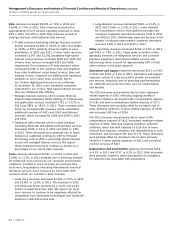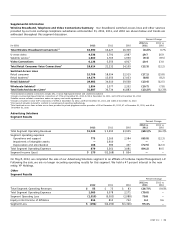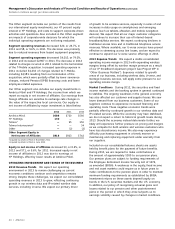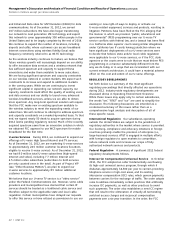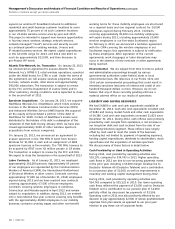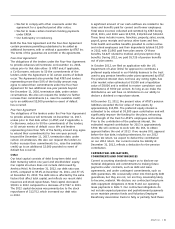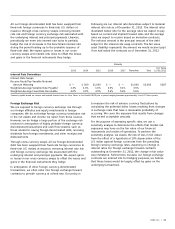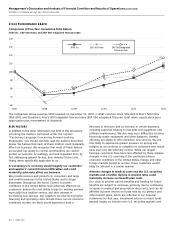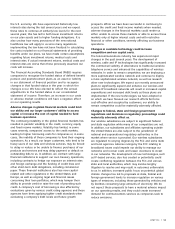AT&T Wireless 2012 Annual Report Download - page 48
Download and view the complete annual report
Please find page 48 of the 2012 AT&T Wireless annual report below. You can navigate through the pages in the report by either clicking on the pages listed below, or by using the keyword search tool below to find specific information within the annual report.
Management’s Discussion and Analysis of Financial Condition and Results of Operations (continued)
Dollars in millions except per share amounts
46 | AT&T Inc.
We review customer relationships and other long-lived
assets for impairment whenever events or circumstances
indicate that the carrying amount may not be recoverable
over the remaining life of the asset or asset group.
To determine that the asset is recoverable, we verify that
the expected undiscounted future cash flows directly
related to that asset exceed its book value.
We evaluate our investments to determine whether
market declines are temporary and accordingly reflected
in accumulated other comprehensive income, or other-
than-temporary and recorded as an expense in other
income (expense) in the consolidated income statements.
This evaluation is based on the length of time and the
severity of decline in the investment’s value. In 2011 and
2010, we identified an other-than-temporary decline in
the value of immaterial equity method investments and
various cost investments.
Income Taxes Our estimates of income taxes and
the significant items giving rise to the deferred assets
and liabilities are shown in Note 10 and reflect our
assessment of actual future taxes to be paid on items
reflected in the financial statements, giving consideration
to both timing and probability of these estimates.
Actual income taxes could vary from these estimates due
to future changes in income tax law or the final review of
our tax returns by federal, state or foreign tax authorities.
We use our judgment to determine whether it is more
likely than not that we will sustain positions that we have
taken on tax returns and, if so, the amount of benefit
to initially recognize within our financial statements.
We regularly review our uncertain tax positions and adjust
our unrecognized tax benefits (UTBs) in light of changes
in facts and circumstances, such as changes in tax law,
interactions with taxing authorities and developments in
case law. These adjustments to our UTBs may affect our
income tax expense. Settlement of uncertain tax positions
may require use of our cash.
OTHER BUSINESS MATTERS
Retiree Phone Concession Litigation In May 2005, we were
served with a purported class action in U.S. District Court,
Western District of Texas (Stoffels v. SBC Communications Inc.),
in which the plaintiffs, who are retirees of Pacific Bell Telephone
Company, Southwestern Bell and Ameritech, contended that
the cash reimbursement formerly paid to retirees living outside
their company’s local service area, for telephone service they
purchased from another provider, was a “defined benefit plan”
within the meaning of ERISA. In January 2011, the trial court
entered a final judgment in our favor. Plaintiffs appealed the
judgment to the Fifth Circuit Court of Appeals and in April
2012, the Fifth Circuit affirmed the lower court’s judgment in
our favor dismissing the case. In July 2012, Plaintiffs filed a
petition for a writ of certiorari in the U.S. Supreme Court, which
was denied in October 2012, thereby ending the litigation.
using a discounted cash flow model (the Greenfield
Approach). The Greenfield Approach assumes a company
initially owns only the wireless FCC licenses, and then
makes investments required to build an operation
comparable to the one that currently utilizes the licenses.
We utilized a 17-year discrete period to isolate cash
flows attributable to the licenses, including modeling
the hypothetical build-out. The projected cash flows are
based on certain financial factors, including revenue
growth rates, EBITDA margins and churn rates.
For impairment testing purposes, we assumed wireless
revenue growth to trend down from our 2012 growth rate
of 5.6% to a long-term growth rate that reflects expected
long-term inflation trends. We assumed our churn rates
will decline in 2013 from our rate of 1.35% in 2012, in
line with expected trends in the industry but at a rate
comparable with industry-leading churn. EBITDA margins
were assumed to continue to trend at least 40%.
This model then incorporates cash flow assumptions
regarding investment in the network, development of
distribution channels and the subscriber base, and other
inputs for making the business operational. We based the
assumptions, which underlie the development of the
network, subscriber base and other critical inputs of the
discounted cash flow model, on a combination of average
marketplace participant data and our historical results,
trends and business plans. We also used operating
metrics such as capital investment per subscriber,
acquisition costs per subscriber, minutes of use per
subscriber, etc., to develop the projected cash flows.
Since we included the cash flows associated with these
other inputs in the annual cash flow projections, the
present value of the unlevered free cash flows of the
segment, after investment in the network, subscribers,
etc., is attributable to the wireless FCC licenses.
The terminal value of the segment, which incorporates
an assumed sustainable growth rate, is also discounted
and is likewise attributed to the licenses. We used a
discount rate of 9%, based on the optimal long-term
capital structure of a market participant and its associated
cost of debt and equity, to calculate the present value
of the projected cash flows. This discount rate is also
consistent with rates we use to calculate the present
value of the projected cash flows of licenses acquired
from third parties.
If either the projected rate of long-term growth of cash
flows or revenues declined by 1%, or if the discount rate
increased by 1%, the fair values of the wireless FCC
licenses, while less than currently projected, would still be
higher than the book value of the licenses. The fair value of
the licenses exceeded the book value by more than 25%.


